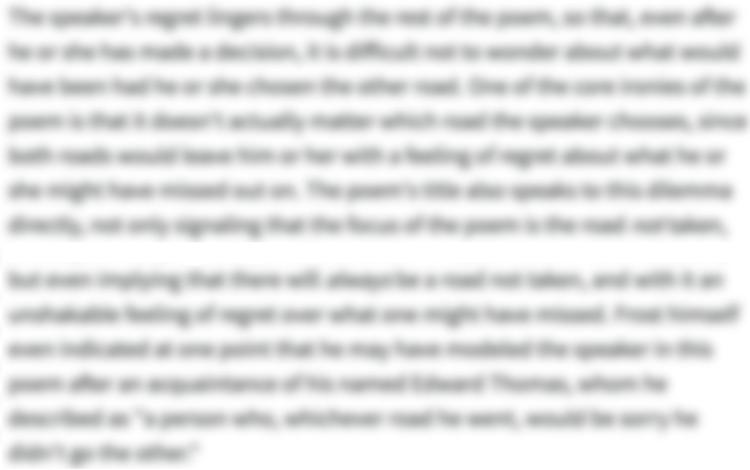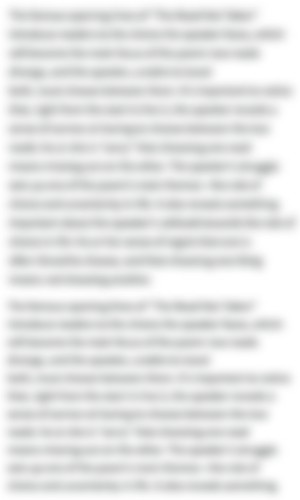-
“Blessing” Introduction
-
"Blessing" appears in Imtiaz Dharker's collection Postcards from God (1997). It depicts the sudden bursting of a water pipe in a neighborhood where water is scarce. As a shower of municipal water rains down, the surrounding residents run to cool off under it and gather it in containers. Though the scene is communal and joyful, it's also "frantic" and a little disturbing: the "sudden / rush of fortune" highlights the mass deprivation that it has only briefly relieved. Inspired by the Dharavi neighborhood of Mumbai, India, the poem is both a community snapshot and a comment on inequality and climate change.
-
-
“Blessing” Summary
-
People's skin becomes so dehydrated in this climate that it cracks like a seedpod. There's an endless water shortage here.
Picture water drops falling, plinking, ringing in a tin mug, as if they were the expression of a benevolent deity.
Occasionally, there's an abrupt burst of good luck. A city water pipe breaks, and silvery water cascades all over the street, causing people to shout with surprise. A crowd emerges from their humble homes. Everyone in the surrounding streets jostles toward the water, carrying brass, copper, and aluminum pots and plastic pails, reaching out desperate hands.
Naked kids shriek in the sunlit shower of water, gleaming as if perfectly scrubbed, catching the light as the miracle splashes over their tiny, frail bodies.
-
-
“Blessing” Themes
-

Scarcity, Poverty, and Desperation
Imtiaz Dharker's "Blessing" portrays a community with a hot, dry climate where water is scarce. When water suddenly gushes from a broken "municipal pipe," the whole community crowds in to cool off and collect water while they can. Though the resulting scene is joyful, it's also "frantic" and ominous; though there seems to be plenty of water for now, the speaker notes, there "never is enough." And while the poem shows how shared hardship can create scenes of communal "congregation," it depicts scarcity and poverty, on the whole, as sources of constant desperation and fear.
The poem establishes that this is an impoverished community desperate for water. The community lives in "huts," or simple houses, and children are "naked,” suggesting they lack adequate clothing. (While it’s also possible they’ve undressed just to bathe, nakedness is often associated with exposure and deprivation.) The speaker says that "There never is enough water" to go around, and the dehydrated "skin" of the residents "cracks like a pod." In other words, the lack of water is stressful and painful. The community daydreams about just "the drip of" water, seeking or awaiting it like "the voice of a kindly god." These fantasies speak to how desperate they are—a desperation the speaker urges the reader to "Imagine."
In this environment, the occasional overflow of water feels like a "Blessing," one that fosters joy and communal togetherness. But the poem hints that it also breeds competition and desperation—and it's not a real solution to the problem of scarcity. Whenever "The municipal pipe bursts," the community greets it as a "sudden rush / of fortune." This is the "Blessing" of the title, and the people crowd around it like a religious "congregation," cooling off in the hot "sun" and collecting the water like precious "silver."
While the scene seems ecstatic, it's also disturbing. The abundant water is a freak accident, not the product of socioeconomic change—or, for that matter, divine favor. Meanwhile, the crowd doesn't just congregate; it "butts in," jostling competitively to gather the water. The local children "scream[]" at the water's arrival. While they're presumably excited, the word choice is a disturbing reminder that, on other occasions, they've likely "scream[ed]" out of frustration, fear, and/or thirst. In the poem's final image, "the blessing [of water] sings / over their small bones." It's an image of temporary abundance, but also a stark illustration of the children's vulnerability. It carries the suggestion that they may be undernourished (skeletally thin) as well as dehydrated, and it symbolically raises the specter of death—a possible consequence of scarcity.
While the poem doesn't name its setting, its descriptions evoke various hot, arid, and impoverished regions of the Global South. These are regions where water scarcity is a real and growing problem—one that other countries and the wealthy elite often cruelly ignore—so "Blessing" can be read as a political poem illustrating contemporary struggles. More broadly, it reflects the complex communal experience of poverty and scarcity, including the way sporadic relief from deprivation can seem like both a "Blessing" and the sign of a larger cruelty.
Where this theme appears in the poem:- Lines 1-23
-
-
Line-by-Line Explanation & Analysis of “Blessing”
-
Lines 1-2
The skin cracks ...
... is enough water.The poem begins with a compact two-line stanza. The first line is a simile, and the second offers context for that simile:
The skin cracks like a pod.
There never is enough water.These lines begin to describe the poem's setting without naming a particular place. This is a location that suffers from a chronic water shortage, perhaps a community located in a hot, dry climate. In fact, "water" is so scarce here that "The skin cracks like a pod," or seedpod. As people (and animals) struggle with chronic dehydration, their skin painfully chaps and cracks. This opening simile is a subtle reminder that humans are part of nature; we're forced to contend with the climate just like plants and other creatures.
From the start, the poem's sound helps bring its imagery to life. The /k/ consonance in the opening line—"The skin cracks like a pod"—sounds harsh and unpleasant, like the condition this line describes. The /n/ consonance in line 2 drives home the fact of scarcity: "There never is enough water." Though the poem is written in free verse, devices like consonance and assonance add lyricism and dramatic punch to its language. Meanwhile, the short, sparse lines of these opening stanzas seem to reflect the shortage of water—especially compared with the freer-flowing lines of later stanzas.
-
Lines 3-6
Imagine the drip ...
... a kindly god.

Unlock all 229 words of this analysis of Lines 3-6 of “Blessing,” and get the Line-by-Line Analysis for every poem we cover.
Plus so much more...
Get LitCharts A+ -
Lines 7-12
Sometimes, the sudden ...
... a congregation: -
Lines 12-17
every man woman ...
... frantic hands, -
Lines 18-23
and naked children ...
... their small bones.
-
-
“Blessing” Symbols
-

Water
Because water is essential to survival, it's a symbol of life, energy, and vitality. (Think of idioms like "overflowing with joy" or the metaphor of "an oasis in the desert," meaning a source of sustenance amid hardship.) Because it's used in washing, it can also represent purity and cleanliness. In many traditions, it's associated with holiness and spiritual renewal (think of baptism ceremonies, for example).
"Blessing" plays on all these associations. In the arid climate of the poem, the smallest "drip" of water seems holy, like "the voice of a kindly god." Occasionally, it bursts into the streets of the community as a "bless[ed]" force of renewal. It flows from the municipal pipe like a "rush / of fortune," almost a divine gift. It seems to restore the energy of the community, which throngs around it like a religious "congregation." As "naked children" bathe in it, it contributes to an image of purity and innocence. Water, in the poem, is more than water; it's a symbol of divine favor, luck, and miraculous good fortune.
All this symbolism implies what the poet has said explicitly about Dharavi, the Mumbai slum on which the poem's setting is based:
If the monsoon arrives, if the water comes by some miracle of God, by some act of kindness or some great mistake, which [the people] wait for—if that water arrives, it's a miracle.
That water is considered such a "blessing," meanwhile, emphasizes the poverty and deprivation of this place, where something essential to life becomes a luxury.
Where this symbol appears in the poem:- Line 2: “There never is enough water.”
- Lines 3-6: “Imagine the drip of it, / the small splash, echo / in a tin mug, / the voice of a kindly god.”
- Lines 7-11: “Sometimes, the sudden rush / of fortune. The municipal pipe bursts, / silver crashes to the ground / and the flow has found / a roar of tongues.”
- Line 19: “screaming in the liquid sun,”
- Lines 22-23: “as the blessing sings / over their small bones.”
-
-
“Blessing” Poetic Devices & Figurative Language
-
Metaphor
The poem uses several metaphors (and one simile) to illustrate the importance of water in its arid setting.
First comes a simple but disturbing simile. In this hot, dry climate, according to the speaker, "The skin cracks like a pod"—in other words, the way a seedpod cracks open (to release the seed inside). It's a blunt, effective image of painful dehydration, as well as a reminder that human beings are part of nature. People are as affected by the climate as plants and other creatures.
The second stanza compares the "drip" and "splash" of water (what little water there is) to "the voice of a kindly god." This metaphor connects water with the sacred or divine—a connection that runs throughout the poem. When water is scarce, the speaker suggests, even a "small" droplet seems like a "Blessing" or gift from heaven. Similarly, any overflow of water seems like a "sudden rush / of fortune," as the metaphor in lines 7-8 makes clear.
The last stanza compares the sun itself to a "liquid" as water from the burst pipe jets into the sky. (In other words, the sun looks visually distorted through the spray.) The kids playing under this sudden sprinkler look "polished to perfection," scrubbed clean by the water drenching them. Finally, the speaker compares the splashing water to a "blessing" that "sings / over their small bones." Once again, the poem links water with the divine, suggesting the power it holds within (and over) this hot, dry region.
Where metaphor appears in the poem:- Line 1: “The skin cracks like a pod.”
- Lines 3-6: “Imagine the drip of it, / the small splash, echo / in a tin mug, / the voice of a kindly god.”
- Lines 7-8: “Sometimes, the sudden rush / of fortune.”
- Line 19: “the liquid sun”
- Line 20: “their highlights polished to perfection,”
- Lines 22-23: “as the blessing sings / over their small bones.”
-
Imagery
-
Juxtaposition
-
Consonance
-
Assonance
-
-
“Blessing” Vocabulary
Select any word below to get its definition in the context of the poem. The words are listed in the order in which they appear in the poem.
- Pod
- Municipal pipe
- Congregation
- Aluminium
- Highlights
Pod-
(Location in poem: Line 1: “The skin cracks like a pod.”)
The poet probably has in mind a seedpod, a pouch that grows on plants and can be "crack[ed]" open to release the enclosed seeds.
-
Form, Meter, & Rhyme Scheme of “Blessing”
-
Form
"Blessing" is a free verse poem divided into four stanzas of uneven length. The stanzas break up the narrative into organic pieces, like paragraphs in a story. For example, the first stanza crystallizes the poem's dramatic conflict in two pithy lines (an image/simile followed by explanatory context). The third presents a more extended, complex description of rushing water and gathering crowds. Meanwhile, the poem's lines range from three to ten syllables in length.
The choice of free verse suits the spontaneous, disorderly scene that the poem describes. An orderly, predictable form would have clashed with this image of crowd commotion. The stanza lengths are also significant: the first two stanzas, which describe a severe water shortage, are extremely concise. The last two stanzas, which describe the gushing water main, flow at greater length. The longest individual lines in the poem also occur in these last two stanzas. In this way, the poem's form reflects the transition from scarcity to abundance.
-
Meter
"Blessing" is a free verse poem, so it doesn't have a meter. Its lines are generally on the shorter side, but they range from three syllables. This variation affords the poet flexibility in describing a complex, chaotic scene.
More broadly, the unpredictability of the lines seems to reflect the nature of life in this "municipal[ity]." Here, "fortune" itself can be stingy or generous from moment to moment. For example, the residents may go weeks or months with very little water, then experience a "sudden rush" of water. (Though there "never is enough water"—one reason, perhaps, that the lines never become long and flowing.)
-
Rhyme Scheme
As a free verse poem, "Blessing" has no rhyme scheme. However, there are occasional, subtle rhymes or slant rhymes at the ends of lines: for example, "pod"/"god" (lines 1 and 6), "ground"/"found"/"around" (lines 9, 10, and 13), and "huts"/"pots" (lines 11 and 14). Though these rhymes may seem incidental, they add to the poem's musicality and emotional intensity. (Notice that they cluster around the passage where the long-awaited water "bursts" forth.)
-
-
“Blessing” Speaker
-
The poem is narrated by a third-person speaker, whose identity (age, gender, etc.) is never specified. It's possible that the speaker is speaking on behalf of the community they describe—this neighborhood in which "There never is enough water." However, the speaker never uses a collective "we" and could be an outside observer as well.
At one moment, in the second stanza (lines 3-6), the speaker addresses the reader directly:
Imagine the drip of it,
the small splash, echo
in a tin mug,
the voice of a kindly god.This effect makes the community's plight more immediate, encouraging the reader's sympathy.
Dharker has said that she based the poem on her observations of Dharavi, a poor neighborhood in Mumbai, India. Hence, the speaker could be read as the poet herself, reporting on the sights and sounds of the city where she lives part-time.
-
-
“Blessing” Setting
-
The poem is set in a community that experiences chronic water shortages. This seems to be an urban setting, since it features a "municipal [water] pipe" surrounded by crowded "streets." The people live in simple "huts," so it's likely a struggling city or a poor neighborhood within a larger city. The persistent dry spells—"There never is enough water"—indicate a hot, dry climate, perhaps somewhere in the Global South. (Many parts of this region face a real and worsening water crisis.)
Dharker has revealed that she based "Blessing" on real events in Dharavi, a large, crowded slum in Mumbai, India. However, the poem keeps its geographical location unspecified, perhaps in order to suggest that its description could apply to many places around the world.
-
-
Literary and Historical Context of “Blessing”
Literary Context
Imtiaz Dharker is a British poet who was born in Lahore, the capital of Pakistan, in 1954. She grew up primarily in Glasgow, Scotland, where her family moved when she was one year old. Dharker studied at the University of Glasgow, graduating with an M.A. in English Literature and Philosophy. She now divides her time between London and Mumbai, whose hot, dry climate and Dharavi neighborhood inspired this poem's setting.
Dharker has published numerous books of poetry, mostly with the publisher Bloodaxe Books. Common themes among her books include questions of identity, home and exile, cultural displacement, and community. Similar themes can be found in Carol Rumens's "The Emigrée" and W. H. Auden's "Refugee Blues." Other poets have also used the home as a metaphor for human relationships, as can be seen in Simon Armitage's "Mother, any distance."
Dharker's poetry is well-established, featuring on the GCSE syllabus in the UK and earning Dharker a Cholmondeley Prize in 2011 and a Queen's Gold Medal in 2014. She is also a member of the Royal Society of Literature. In addition to her poetry, Dharker also works as an artist and a documentary maker.
Historical Context
Dharker has explained that she had the slums of Mumbai, India in mind when writing this poem. Despite India's recent rapid economic growth, over 40 percent of the population of Mumbai (India's largest city, formerly known as Bombay) lives in slums. The largest of these poorer neighborhoods is Dharavi, which has a population of around 700,000. Much of this population density stems from migration, as people move to the city seeking greater economic opportunity.
"Blessing" depicts the kind of water shortages that frequently afflict this area. According to Dharker, during the "stifling, jostling heat" of the dry season, the arrival of water—whether via monsoon, an "act of kindness," or a "mistake"—represents a "miracle" for Mumbai's poorer residents:
[...] In England, if the sun comes out, life changes, clothes come off, people's attitude, people's life changes. In many ways, in a magnified way, the moment when water arrives, [that's] what happens in that Bombay slum. This poem is really about that.
At the same time, the poem highlights the vibrant expression of life that these slums represent. Though they are difficult and impoverished places to live, their residents persist with their lives in the face of immense challenges. And while Mumbai was the "municipal[ity]" that inspired "Blessing," the poem doesn't specify a location, suggesting that the kind of scene it portrays occurs in cities around the world.
In particular, the so-called Global South (including parts of Southeast Asia, South America, and Africa) faces a mounting water crisis. Climate change and global income inequality already threaten millions of people's access to clean, reliable water sources. This crisis poses one of the major political challenges of the 21st century; it's the kind of problem an occasional happy accident or "blessing" can't solve.
-
More “Blessing” Resources
-
External Resources
-
The Poem Aloud — Imtiaz Dharker introduces and reads her poem.
-
An Interview with the Poet — Dharker discusses her life and work.
-
Dharker at the Poetry Archive — A short biography and exhibit about the poet.
-
The Author's Website — Check out Imtiaz Dharker's personal website, featuring media coverage, the poet's visual art, and more.
-
Water Scarcity and Climate Change — "Blessing" describes a problem that afflicts many communities worldwide. Read an NPR report about water shortages in the Global South.
-
-
LitCharts on Other Poems by Imtiaz Dharker
-








